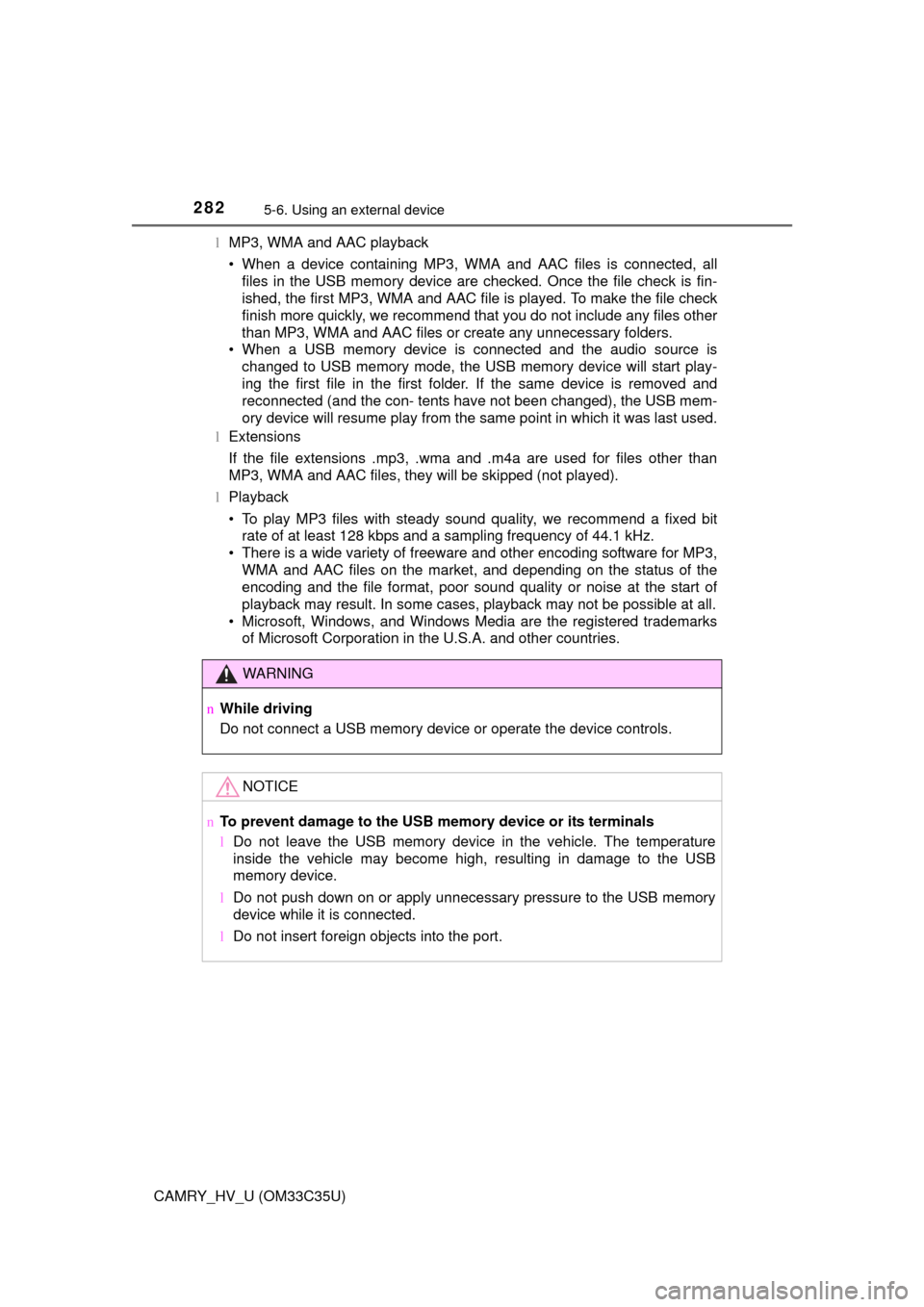Page 4 of 572

TABLE OF CONTENTS4
CAMRY_HV_U (OM33C35U)5-1. Basic Operations
Audio system types ........... 248
Audio system..................... 250
Steering wheel audio switches .......................... 252
USB port/AUX port ............ 253
Basic audio operations ...... 255
5-2. Setup Setup menu ....................... 257
General settings ................ 258
Audio settings.................... 260
Display settings ................. 261
Voice settings .................... 262
5-3. Using the Multimedia system
Selecting the audio source ............................. 263
List screen operation ......... 264
Optimal use of the multimedia system .......... 266 5-4. Using the radio
Radio operation ................. 267
5-5. Playing an audio CD and MP3/WMA/AAC discs
CD player operation........... 269
5-6. Using an external device Listening to an iPod ........... 275
Listening to a USB memory device ................ 279
Using the AUX port ............ 283
5-7. Connecting Bluetooth
®
Preparations to use wireless
communication ................ 284
Registering a Bluetooth
®
audio player for the
first time ........................... 288
Registering a Bluetooth
®
phone for the
first time ........................... 289
Registering a Bluetooth
®
device .............................. 290
Connecting a Bluetooth
®
device .............................. 292
Displaying a Bluetooth
®
device details................... 294
Detailed Bluetooth
®
system settings................ 295
5Audio system
Page 246 of 572
246
CAMRY_HV_U (OM33C35U)5-1. Basic Operations
Audio system types ........... 248
Audio system .................... 250
Steering wheel audio switches .......................... 252
USB port/AUX port ............ 253
Basic audio operations...... 255
5-2. Setup Setup menu....................... 257
General settings ................ 258
Audio settings ................... 260
Display settings ................. 261
Voice settings.................... 262
5-3. Using the Multimedia system
Selecting the audio source ............................. 263
List screen operation......... 264
Optimal use of the multimedia system .......... 266
5-4. Using the radio Radio operation................. 267
5Audio system
Page 247 of 572

247
5Audio system
CAMRY_HV_U (OM33C35U)5-5. Playing an audio CD and
MP3/WMA/AAC discs
CD player operation .......... 269
5-6. Using an external device Listening to an iPod .......... 275
Listening to a USB memory device................ 279
Using the AUX port ........... 283
5-7. Connecting Bluetooth
®
Preparations to use wireless
communication ................ 284
Registering a Bluetooth
®
audio player for the
first time .......................... 288
Registering a Bluetooth
®
phone for the first time .... 289
Registering a Bluetooth
®
device.............................. 290
Connecting a Bluetooth
®
device.............................. 292
Displaying a Bluetooth
®
device details .................. 294
Detailed Bluetooth
®
system settings ............... 295 5-8. Bluetooth
® Audio
Listening to Bluetooth®
Audio ............................... 296
5-9. Bluetooth
® phone
Using a Bluetooth®
Phone ............................. 297
Making a call ..................... 299
Receiving a call ................. 302
Speaking on the phone ..... 303
Bluetooth
® phone
message function ............ 306
Using the steering wheel switches ................ 309
Bluetooth
® phone
settings ........................... 310
Contact/Call History Settings ........................... 311
What to do if... (Troubleshooting) ............ 319
5-10. Bluetooth
®
Bluetooth®......................... 323
5-11. Using the voice command system
Voice command system .... 328
Page 253 of 572
2535-1. Basic Operations
5
Audio system
CAMRY_HV_U (OM33C35U)n
iPod
Push the lid.
Open the cover and connect
an iPod using an iPod cable.
Turn on the power of the iPod if
it is not turned on.
n
USB memory device Push the lid.
Open the cover and connect the USB memory device.
Turn on the power of the USB memory device if it is not turned on.
n
Portable audio player
Push the lid.
Open the cover and connect the portable audio player.
Turn on the power of the portable audio player if it is not turned on.
USB port/AUX port
Connect an iPod, USB memory device or portable audio player
to the USB/AUX port as indicated below. Select “iPod”, “USB” or
“AUX” on the audio sour ce selection screen and the device can
be operated via multimedia system.
Connecting using the USB/AUX port
1
2
1
2
1
2
Page 265 of 572
2655-3. Using the Multimedia system
5
Audio system
CAMRY_HV_U (OM33C35U)n
Selecting a track/file/song
from the track/file/song list
Select “Browse” or cover art.
Select the desired track/file/
song.
When an MP3/WMA/AAC disc or USB memory device is being used,
the folder can be selected. When a Bluetooth
® device or iPod is being
used, the album can be selected.
According to the audio device, the following is displayed.
1
2
Audio sourceList name
Audio CDTrack
MP3/WMA/AAC discFolder, File
Bluetooth®Album, Track
USBArtists, Albums, Songs, Genres,
Composers
iPodArtists, Albums, Songs, Genres,
Composers, Audiobooks, Videos
Page 279 of 572
2795-6. Using an external device
5
Audio system
CAMRY_HV_U (OM33C35U)
P. 2 5 3
Pressing the “AUDIO” button disp lays the audio control screen from
any screens of the selected source.
Audio source selection screen
appears
Displays cover art
Displaying the folder list
Random playback ( P. 255)
Repeat play ( P. 255)
Pause
Select to resume playback
Setting the sound ( P. 266)
Select “Browse” on the screen.
Select the desired play mode. Then select a song to begin using
the selected play mode.
nDisplaying the now playing list
Touch the cover art display.
Listening to a USB memor y device
Connecting a USB memory device enables you to enjoy music
from the vehicle speakers.
Touch “USB” on the audio source selection screen.
Connecting a USB memory device
Audio control screen
1
2
3
4
5
6
Selecting a play mode
7
1
2
Page 280 of 572

2805-6. Using an external device
CAMRY_HV_U (OM33C35U)
nUSB memory functions
lDepending on the USB memory device that is connected to the system, the
device itself may not be operable and certain functions may not be avail-
able. If the device is inoperable or a function is unavailable due to a mal-
function (as opposed to a system specification), disconnecting the device
and reconnecting it may resolve the problem.
l If the USB memory device still does not begin operation after being discon-
nected and reconnected, format the memory.
n Error messages for USB memory
n USB memory
lCompatible devices
USB memory device that can be used for MP3, WMA and AAC playback.
l Compatible device formats
The following device format can be used:
• USB communication format: USB2.0 HS (480 Mbps) and FS (12 Mbps)
• File system format: FAT16/32 (Windows)
• Correspondence class: Mass storage class
MP3, WMA and AAC files written to a device with any format other than
those listed above may not play correctly, and their file names and folder
names may not be displayed correctly.
Items related to standards and limitations are as follows:
• Maximum directory hierarchy: 8 levels
• Maximum number of folders in a device: 3000 (including the root)
• Maximum number of files in a device: 9999
• Maximum number of files per folder: 255
l MP3, WMA and AAC files
MP3 (MPEG Audio LAYER 3) is a standard audio compression format.
Files can be compressed to approximately 1/10 of their original size usi\
ng
MP3 compression.
WMA (Windows Media Audio) is a Mi crosoft audio compression format. This
format compresses audio data to a size smaller than that of the MP3 format.
AAC is short for Advanced Audio Coding and refers to an audio compression
technology standard used with MPEG2 and MPEG4.
MP3, WMA and AAC file and media/formats compatibility are limited.
MessageCause/Correction procedures
“Connection error. Please
consult your Owner’s Man-
ual for instructions on how
to connect the USB device.”
This indicates a problem with the USB mem-
ory device or its connection.
“There are no files available
for playback. Please add
compatible files to your USB
device.”
This indicates that no MP3/WMA/AAC files
are included on the USB memory device.
Page 282 of 572

2825-6. Using an external device
CAMRY_HV_U (OM33C35U)l
MP3, WMA and AAC playback
• When a device containing MP3, WMA and AAC files is connected, all
files in the USB memory device are checked. Once the file check is fin-
ished, the first MP3, WMA and AAC file is played. To make the file check
finish more quickly, we recommend that you do not include any files other
than MP3, WMA and AAC files or create any unnecessary folders.
• When a USB memory device is connected and the audio source is
changed to USB memory mode, the USB memory device will start play-
ing the first file in the first folder. If the same device is removed and
reconnected (and the con- tents have not been changed), the USB mem-
ory device will resume play from the same point in which it was last used.
l Extensions
If the file extensions .mp3, .wma and .m4a are used for files other than
MP3, WMA and AAC files, they will be skipped (not played).
l Playback
• To play MP3 files with steady sound quality, we recommend a fixed bit
rate of at least 128 kbps and a sampling frequency of 44.1 kHz.
• There is a wide variety of freeware and other encoding software for MP3, WMA and AAC files on the market, and depending on the status of the
encoding and the file format, poor sound quality or noise at the start of
playback may result. In some cases, playback may not be possible at all.\
• Microsoft, Windows, and Windows Media are the registered trademarks of Microsoft Corporation in the U.S.A. and other countries.
WARNING
nWhile driving
Do not connect a USB memory device or operate the device controls.
NOTICE
nTo prevent damage to the USB memory device or its terminals
lDo not leave the USB memory device in the vehicle. The temperature
inside the vehicle may become high, resulting in damage to the USB
memory device.
l Do not push down on or apply unnecessary pressure to the USB memory
device while it is connected.
l Do not insert foreign objects into the port.